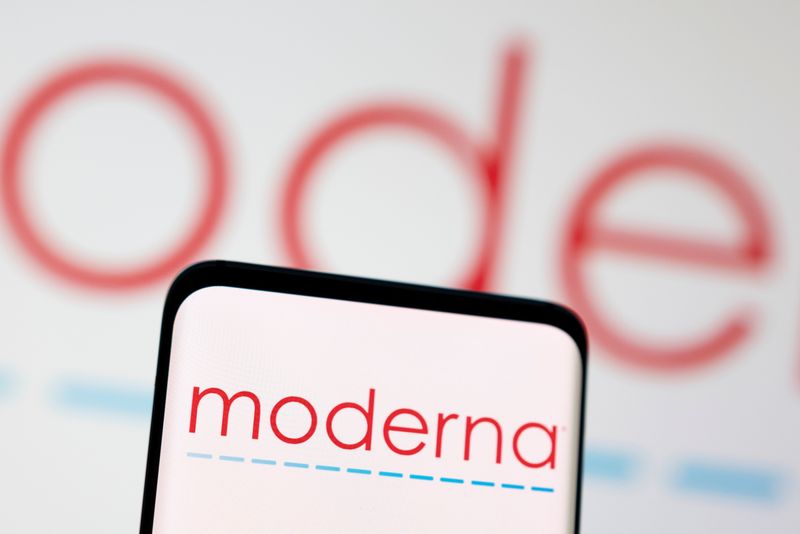By Manas Mishra and Michael Erman
(Reuters) -Moderna Inc on Thursday cut its 2022 COVID-19 vaccine sales forecast, citing regulatory and production delays, and issued a 2023 outlook for the shots well below Wall Street estimates, and its shares fell as much as 9% before recovering.
It expects $4.5 billion to $5.5 billion in sales from signed COVID vaccine contracts for next year, while analysts’ estimates were at $9.5 billion.
That forecast comes despite the company delaying up to $3 billion worth of 2022 vaccine sales it would now deliver in 2023 due to quality control issues at its contract manufacturing partner. The company did say the 2023 outlook excludes expected contracts with countries such as the United States and Japan, and that it anticipated the forecast to be the “floor” for next year’s sales.
Demand for COVID vaccines has waned globally. Moderna (NASDAQ:MRNA) agreed earlier this year to push back deliveries on its contract with the European Union to late 2022 or early 2023. It also canceled an existing deal with vaccine alliance GAVI, and struck a new deal to instead to supply the organization up to 100 million doses of its updated booster vaccine in 2023 for some of the world’s poorest countries.
Moderna’s new sales forecast comes after Pfizer Inc (NYSE:PFE) said it plans to quadruple the price of its COVID-19 shot once the United States moves away from government funding to a private market for COVID-19 vaccines next year.
Moderna declined to answer questions on a new U.S. price during a conference call to discuss third-quarter results. The company said the private market could be unpredictable and that vaccine deliveries might become seasonal, such as with flu shots.
“We anticipate a more fragmented customer base, including private payers, health plans, pharmacy chains, individual pharmacies and physician offices,” said Arpa Garay, Moderna’s chief commercial officer. “We also anticipate reduced predictability in orders.”
PRODUCTION CHALLENGES
Along with production delays, Moderna’s third quarter was marred with manufacturing complexities due to shifting from 10-dose vials to 5-dose vials and the roll out of new bivalent vaccines that target both the original coronavirus and Omicron variants, Chief Executive Stephane Bancel said.
“We are working through a lot of those issues as we speak,” he said.
Quality control issues at contract manufacturer Catalent (NYSE:CTLT) have led to a slow rollout of Moderna’s retooled COVID-19 boosters.
The U.S. health regulator has been authorizing doses made at the Catalent plant on a batch-by-batch basis.
“You can tell the infancy of this company versus a Pfizer, which is scaled up and ready, and can manufacture and ship out,” said Sara LaFever, analyst at Citeline.
Moderna now expects 2022 vaccine sales of $18 billion to $19 billion compared to a prior forecast of $21 billion.
According to EU data, only around 2 million doses of Moderna’s updated bivalent COVID vaccine have been distributed there so far, compared with more than 13 million doses of the updated Pfizer-BioNTech vaccine. In the United States, Moderna has distributed around 18.4 million doses of the new vaccine, compared with about 41.4 million Pfizer-BioNTech doses.
Third-quarter sales of $3.36 billion fell short of Wall Street estimates of $3.53 billion.
After initially falling to as low as $135.09 in early trading, Moderna shares bounced back and closed at $148.47, just 15 cents below Wednesday’s close.
We encourage you to use comments to engage with other users, share your perspective and ask questions of authors and each other. However, in order to maintain the high level of discourse we’ve all come to value and expect, please keep the following criteria in mind:
Perpetrators of spam or abuse will be deleted from the site and prohibited from future registration at Investing.com’s discretion.

